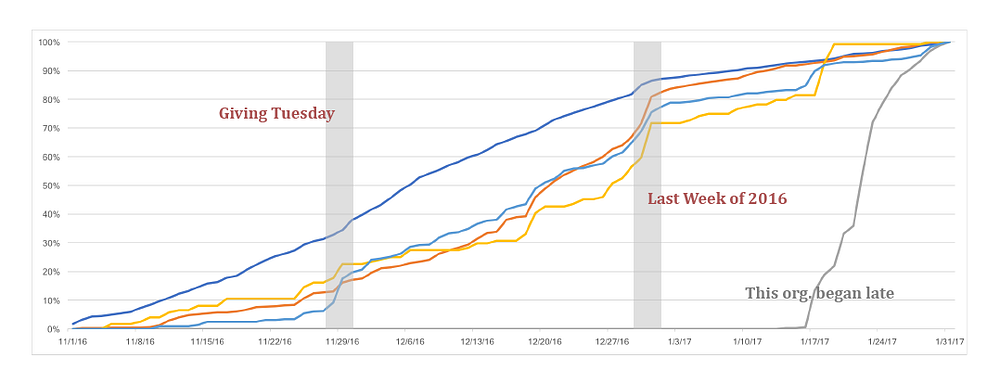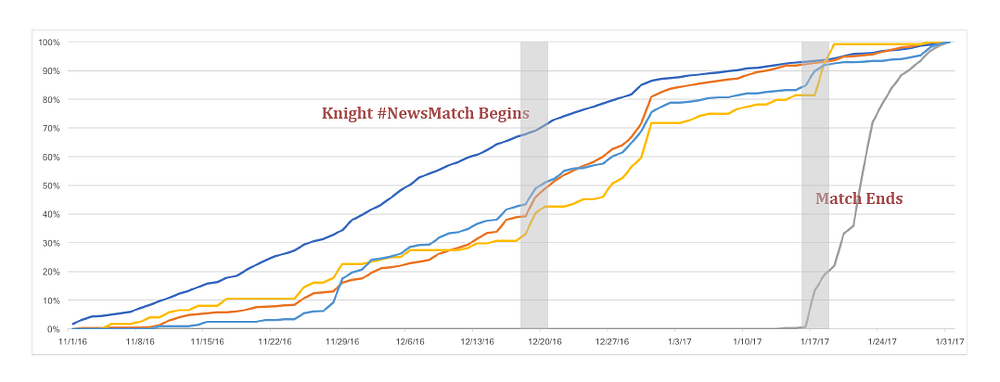March 29, 2017
Four Lessons from the Launch of the News Revenue Hub
Readers support real journalism when given the chance

Civil Beat morning coffee. Credit: Ben Nishimoto
What happens when five news organizations enlist in a program to launch (or re-launch) their membership programs together? In December 2016, the Voice of San Diego launched the News Revenue Hub with funding from Democracy Fund to find out.
The pilot included Honolulu Civil Beat, InsideClimate News, NJ Spotlight, PolitiFact and The Lens.
If you’re not already familiar with nonprofit funding, there are a couple things that are important to know right away. The first is that nearly a third of all individual donations happen in December. In fact, more than 10 percent of donations are made during just the final three days of the year. Donors are procrastinators. For nonprofit fundraisers, the entire fundraising calendar revolves around year-end campaigns and planning starts in the summer, if not sooner.
The second thing to know is that monthly giving is officially a trend. In 2015, monthly giving grew at a faster rate than one-time giving, which is great for nonprofits who can now plan around a predictable, stable revenue stream. In fact, online revenue is growing overall for nonprofits — by 12 percent in 2014, 19 percent in 2015 and 14 percent in 2016. So yes, digital subscriptions are growing at the New York Times and the Washington Post. But nonprofit newsrooms — equal parts newsroom and nonprofit, remember — are naturally positioned to benefit from membership if they make it a focus.
Put it all together and there’s no better time than the end of the year to launch a membership program for news.
The top-line results: From Nov. 1 to Jan 31, the five newsrooms in the News Revenue Hub pilot together raised more than $292,000 and a couple hundred thousand more in pledges for future donations. In-depth newsrooms raised $3-$4 per person on their email list, while destination local newsrooms raised $11-$13 per email address. (In-depth newsrooms typically publish less frequently, with fewer daily users.)
Most importantly, the launch showed that collaborative, goal-oriented member recruitment and retention can quickly scale fundraising for member-supported newsrooms of all sizes and shapes.
Lesson 1 — We Can Work and Learn Together
The News Revenue Hub opened a Slack team where Hub staff can talk with each other (distributed across four cities), channels coordinate each organization’s campaigns and data, and all Hub members can chat with each other. This communication platform is the fairy dust making this project truly transformative for everyone.
“The most valuable part is access,” Civil Beat’s director of philanthropy Ben Nishimoto shared. “We love Slack.”
Typically executive directors and fundraising directors at small newsrooms work alone. Each is a jack-of-all-trades doing list management, writing appeals, setting strategy, managing consultants or volunteers, thanking donors and scheduling fundraising emails. There’s no lack of hustle, but there’s not a lot of support either.
The Hub has become that missing support team that can provide quick answers to questions and share best practices. It’s also a place to go for moral support and to realize that other people are facing the same challenges. These connections matters to participants on a personal level. One said: “It’s great to be collaborative, great to see we all have the same questions and concerns. We can put our heads together and come up with answers.”
Here is some of the other feedback the group shared:
- “I really like the experience of being on the Slack channel. Questions help each other. We’re not in this alone.”
- “I feel like we’re part of a bigger community.”
- “We’re not going off to conferences to meet each other all the time. Working on a project like this opens up a communications channel that will be used for other things ultimately.”
Lesson 2 — We Need to Want to Change
The News Revenue Hub finds a middle ground between a one-size-fits-all template for a membership program and complete customization. Each organization came in with a different fundraising history, membership structure and donor base. They’d all been successful to a point with what they tried to do. But each also realized they had to make changes to take the next step toward sustainability.
One of the key benefits of the Hub has been providing a technical and membership infrastructure that allows individual organizations to focus on the what they know and what they do best. As a result, each organization has built up its fundraising skill set, developing as nonprofit professionals, as they’ve been pushed to focus on those questions that matter most to their organization in the long run.
“I have a lot more confidence,” one participant said. Not that change is necessarily easy. “There was a surprising amount of work at the front end,” another said. A membership program ripples out to other kinds of organizational changes too. Better audience engagement or events that are more interesting to readers. “We work very much on anecdotal evidence. It’ll be very nice to actually have data,” one participant said.
Lesson 3 — We Can Fundraise Like Nonprofits

The chart above plots individual donations for each of the five organizations between November 1 and January 31. The Y-axis is a percentage to make it easier to compare campaigns, since all the organizations are of different sizes with different fundraising targets.
News Revenue Hub newsrooms sent about six appeals during the year-end campaign. The most donations, and most dollars raised, happened around Giving Tuesday (November 29) and during the last week of the year. Again, that’s what we expect based on giving patterns for the nonprofit sector as a whole. This is great evidence that while journalism is still a relatively new “cause” to raise money against, fundraising practices from the nonprofit sector can transfer.
Asking for money and making the case for member support is an important step. “We were able to expand considerably the fact that we’re nonprofit,” one participant said.
The chart below highlights two other sharp jumps in donations, corresponding to the dates of Knight Foundation’s News Match, which matched up to $25,000 in donations to news organizations that had received previous Knight Foundation support. The matching challenge roughly accounted for a 5–10 percent bump in donations over the course of the campaign for participating groups.

Lesson 4 — We Can Increase Member Support

Voice of San Diego tip jar. Credit: Christina Shih
How do you reconcile the values of journalism with the practices of nonprofit fundraising?
It’s been a consistent storyline of nonprofit news over the last 10 years Asking lots of people for small amounts of money, as journalists, was not what many founders set out to do. “A lot of journalists are trained in humility,” one Hub participant said.
That can and will change as organizations evolve. Few nonprofits survive without the kind of small-donor support that membership programs provide, and the evidence suggests that nonprofit news will be no different.
The News Revenue Hub, so far at least, is showing that the technology and business rules that Voice of San Diego developed over a decade are transferable to a variety of journalism organizations. The model allows membership development to scale, breaking through many of the limits that fundraising programs face at small news organizations. It represents a professionalization of the nonprofit news sector, an efficient use of resources and a chance to rally much-needed public support to journalism’s cause.
“There are no shortcuts to some of this work. We should not look for nor expect shortcuts,” Voice of San Diego’s digital director Tristan Loper told me earlier this month. “What we’re doing is so important to get right.”
 Read more about the News Revenue Hub at fundjournalism.org.
Read more about the News Revenue Hub at fundjournalism.org.
This piece was republished with permission.
Jason Alcorn is a nonprofit news consultant with Democracy Fund, a funder of the News Revenue Hub. Follow him on Twitter.













